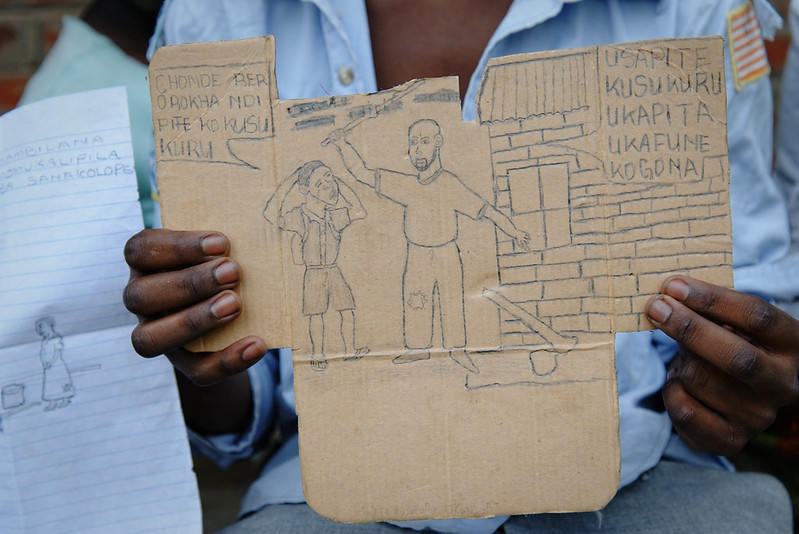Children washing clothes in rivers, begging in the streets, hawking, walking for miles in search of water and firewood, competing with older, more experienced hands to pick coffee or tea, or working as child soldiers are familiar images in the developing South.
Child rights experts reiterate that tolerance and normalisation of child labourers, many of whom work in hazardous conditions and circumstances, and apathy towards the phenomenon have stalled progress towards eliminating child labour.
The International Labour Organization (ILO) estimates that more than 160 million children work worldwide.
It is against this backdrop that the 5th Global Conference on the Elimination of Child Labour is being held in the city of Durban, South Africa, from 15 to 20 May.
The conference will consider how to achieve a specific target on the problem of Goal 8 of the Sustainable Development Goals (SDGs), the one on Decent Work and Economic Growth.
In this goal, target 8.7 calls for immediate action to “ensure the prohibition and elimination of the worst forms of child labour, including the recruitment and use of child soldiers, and by 2025 end child labour in all its forms”.
Durban will also review progress on the International Programme on the Elimination of Child Labour, which focuses on the elimination of child labour by 2025.
The Conference will be opened by the President of South Africa, Cyril Ramaphosa, who will share the stage with the Chairman of the Southern African Development Community (SADC) and President of Malawi, Lazarus McCarthy Chakwera and ILO Director-General Guy Ryder. The President of Argentina, Alberto Fernandez, will also participate virtually.
“There are multiple drivers of child labour in Africa, and many of them are interconnected,” says Minoru Ogasawara, chief technical advisor to the ILO’s Accelerated Action for the Elimination of Child Labour in African Supply Chains (ACCEL).
He speaks of the high prevalence of children working in agriculture, closely linked to poverty and family survival strategies.
Africa’s rapid population growth, says Ogasawara, has put significant pressure on public budgets to maintain or increase the level of services needed to combat child labour, such as education and social protection.
In the case of Africa, it underlines that the container is a long way from the collective commitment to end all forms of child labour by 2025. Another warning is that the number of children working in the sub-Saharan African region is higher than in the rest of the world.
“Hence the call for a substantial increase in funding through official development assistance (ODA), national budgets and private sector contributions to address child labour and its root causes,” Ogasawara notes.
The United Nations Children’s Fund (Unicef) says that approximately 12% of children between the ages of 5 and 14 work, at a cost to their childhood, education and future.
Of the 160 million working children worldwide, more than half are in sub-Saharan Africa, and 53 million are out of school, or 28% of 5–11-year-olds and another 35% of 12–14-year-olds, according to the latest global estimates on child labour by ILO and Unicef.
Against this grim backdrop, Nobel Peace Prize laureates Kailash Satyarthi (India) and Leymah Gbowee (Liberia), as well as former Swedish Prime Minister Stefan Löfven, will address the conference, which is expected to put into perspective how and why children continue to suffer some of the worst and most severe forms of labour exploitation.
These include bonded labour, domestic servitude, child soldiers, drug trafficking and commercial sexual exploitation.
“I am working in collaboration with other Nobel laureates and world leaders. We call for the creation of an international social protection mechanism. During the covid-19 pandemic, we have calculated that $53 billion a year could ensure social protection for all children in all low-income countries, as well as pregnant women,” stressed Satyarthi, the 2014 Nobel Peace Laureate.
Satyarthi has been at the forefront of mobilising global support for the elimination of child labour, as well as children’s right to education and a life free from exploitation and violence.
“Increased social protection, access to free quality education, health care, decent work opportunities for adults and basic services create an enabling environment that reduces the vulnerability of households to child labour,” Ogasawara stresses.
He points to the urgent need for the rapid introduction and or expansion of social security and other social protection measures appropriate to the informal economy, such as cash transfers, school feeding, subsidies for direct education costs and health care coverage.
The need for school-to-work transition and “targeting children from poor households, increasing access to education and reducing the need to combine school and work among children below the minimum working age” should be emphasised, the African specialist argues.
In the absence of such social safety nets, the ILO stresses that there is a danger that nine million more children will join the labour force by the end of the year, highlighting the recurrent obstacles to combating the phenomenon.
In this context, the Durban Conference represents an opportunity to assess the progress made in achieving SDG target 8.7, to discuss good practices implemented by different actors around the world and to identify gaps and urgent measures needed to accelerate the elimination of both child labour and forced labour.
The timing is crucial, the ILO stresses, as there are only three years left to achieve the goal of eliminating all child labour by 2025 and only eight years to eliminate forced labour by 2030.
The Global Conference will also feature the active participation of young survivors of child labour in India and African countries. They will share their first-person accounts and lived experiences in tune with the central theme of the debate.
The meeting will take place against the backdrop of the covid pandemic, amid fears and concerns that the elimination of child labour is slipping down the international agenda as the world grapples with the impact of the pandemic.
This could reverse the many gains made in the fight against child labour, forced labour and child trafficking.












